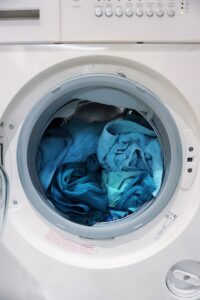Washing machines are an essential appliance in most households, making laundry day a breeze. However, many people take these machines for granted and don’t fully understand how they work. It is important to have a basic understanding of the components and processes of a washing machine to ensure its proper functioning and to troubleshoot any issues that may arise.
A washing machine consists of several key components that work together to clean clothes effectively. These components include the motor, agitator, pump, timer, water inlet valve, drain pump, and spin cycle. Each part plays a crucial role in the overall operation of the machine, and understanding how they work is essential for proper maintenance and repair.
Key Takeaways
- Washing machines have various components and processes that work together to clean clothes.
- Understanding the anatomy of a washing machine can help identify and troubleshoot issues.
- The motor powers the washing machine and drives the agitator and pump.
- The agitator moves clothes around to ensure even cleaning, while the pump removes water from the machine.
- The timer controls the duration of each cycle, and the water inlet valve and drain pump regulate water flow.
The Anatomy of a Washing Machine: Understanding the Parts
To fully comprehend how a washing machine works, it is important to understand the different parts that make up the appliance. The main parts of a washing machine include the drum, agitator, motor, pump, timer, water inlet valve, drain pump, and spin cycle.
The drum is where the clothes are placed for washing. It rotates during the wash cycle to agitate the clothes and remove dirt and stains. The agitator is a central post or spindle that moves back and forth within the drum to further agitate the clothes and enhance the cleaning process.
The motor is responsible for powering the entire washing machine. It provides the necessary energy to rotate the drum, move the agitator, and operate other functions of the machine. Without a functioning motor, the washing machine would not be able to perform its primary function of cleaning clothes.
The Role of the Motor in Washing Machines
The motor is one of the most critical components of a washing machine. It is responsible for powering all the other parts and ensuring that they function properly. The motor provides the necessary energy to rotate the drum during the wash cycle, move the agitator, and operate other functions such as the pump and spin cycle.
A functioning motor is essential for a properly working washing machine. If the motor malfunctions or fails, the machine will not be able to perform its primary function of cleaning clothes. It is important to regularly check and maintain the motor to ensure its longevity and prevent any issues that may arise.
The Function of the Agitator in Washing Machines
The agitator is another crucial component of a washing machine. It is a central post or spindle that moves back and forth within the drum during the wash cycle. The agitator’s primary function is to agitate the clothes and remove dirt and stains effectively.
During the wash cycle, the agitator moves the clothes around in a swirling motion, creating friction between them. This friction helps to loosen dirt and stains from the fabric, allowing the detergent to penetrate and clean more effectively. Without a functioning agitator, clothes may not be cleaned thoroughly, resulting in subpar washing results.
Understanding the Role of the Pump in Washing Machines
The pump is responsible for removing water from the washing machine during the drain cycle. After the clothes have been washed, the pump activates to drain out the dirty water from the drum, making way for clean water during the rinse cycle.
A functioning pump is crucial for proper drainage in a washing machine. If the pump malfunctions or becomes clogged, water may not be effectively removed from the machine, leading to issues such as standing water or improper rinsing. Regular maintenance and cleaning of the pump are essential to ensure its proper functioning.
The Importance of the Timer in Washing Machines

The timer is an integral part of a washing machine as it controls the various cycles and operations of the machine. It determines how long each cycle will run, including wash time, rinse time, and spin time. The timer ensures that each cycle is timed correctly, allowing for efficient and effective cleaning.
A functioning timer is essential for a properly timed wash. If the timer malfunctions or becomes inaccurate, the machine may not run the cycles for the appropriate amount of time, resulting in clothes that are not adequately cleaned or rinsed. Regular maintenance and calibration of the timer are necessary to ensure its accuracy.
The Function of the Water Inlet Valve in Washing Machines
The water inlet valve controls the flow of water into the washing machine. It opens and closes to allow water to enter the machine during the wash and rinse cycles. The water inlet valve is connected to the water supply and is activated by the timer.
A functioning water inlet valve is crucial for maintaining proper water levels in the washing machine. If the valve malfunctions or becomes clogged, water may not enter the machine correctly, leading to issues such as low water levels or no water at all. Regular maintenance and cleaning of the water inlet valve are necessary to ensure its proper functioning.
Understanding the Drain Pump in Washing Machines
The drain pump is responsible for removing water from the washing machine during the drain cycle. After the clothes have been washed and rinsed, the drain pump activates to remove the dirty water from the drum, allowing for a fresh rinse.
A functioning drain pump is essential for proper drainage in a washing machine. If the drain pump malfunctions or becomes clogged, water may not be effectively removed from the machine, leading to issues such as standing water or improper rinsing. Regular maintenance and cleaning of the drain pump are necessary to ensure its proper functioning.
The Significance of the Spin Cycle in Washing Machines
The spin cycle is an essential part of a washing machine as it removes excess water from clothes after they have been washed and rinsed. During this cycle, the drum spins at high speeds, forcing water out of the clothes through centrifugal force.
A functioning spin cycle is crucial for properly dried clothes. If the spin cycle malfunctions or does not operate at the correct speed, clothes may come out of the machine overly wet, requiring additional drying time. Regular maintenance and calibration of the spin cycle are necessary to ensure its proper functioning.
Common Washer Problems and How to Fix Them
Despite regular maintenance and care, washing machines can still experience issues from time to time. Some common problems that homeowners may encounter include leaks, excessive noise, failure to start, or improper cleaning.
To troubleshoot and fix these issues, it is important to first identify the problem. For example, if the machine is leaking, check for any visible cracks or damage to the hoses or seals. If there is excessive noise, inspect the motor or agitator for any loose or worn-out parts.
Once the problem has been identified, homeowners can take appropriate action to fix it. This may involve replacing a faulty part, tightening loose connections, or cleaning out clogged filters or pumps. Regular maintenance and inspection of the washing machine can help prevent these common problems from occurring.
In conclusion, understanding the components and processes of a washing machine is crucial for proper maintenance and repair. By knowing how each part functions, homeowners can troubleshoot and fix common problems, ultimately prolonging the life of their washing machine. Regular maintenance and care are essential to ensure that the machine operates efficiently and effectively, providing clean and fresh laundry for years to come.
If you’re interested in mastering the basics of washers and understanding their components and processes, you may also find our article on “Common Washer Problems and How to Fix Them” helpful. This article provides practical tips and troubleshooting techniques to help you address common issues that may arise with your washer. Check it out here to ensure your washer is always running smoothly.
How Does the Spin Cycle Work in Washers and What are Common Issues That Can Arise?
The spin cycle in washers works by rotating the drum at high speeds to remove excess water from the clothes. Common issues that can arise include unbalanced loads, faulty motor or belt, or clogged drain pump. Troubleshooting spin cycle problems may involve redistributing the load, checking for mechanical issues, or cleaning the drain pump.



